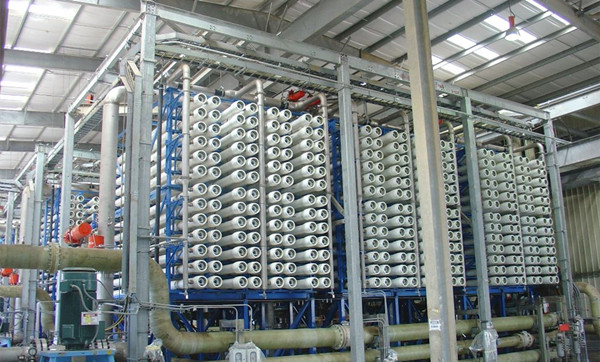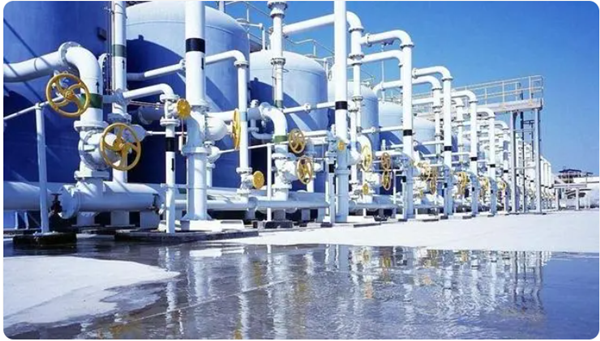In recent years, the seawater desalination policy has been favorable in China, and desalination projects, demonstration and pilot projects in various places have also been launched. Some experts said that there is no best process technology for the process selection of seawater desalination projects, only process technology that is more suitable for the actual project. At present, there are dozens of technical methods for seawater desalination, but the main ones that reach commercial scale are membrane method and thermal method. Most scholars believe that reverse osmosis, low-temperature multi-effect distillation and multi-stage flash evaporation will determine the future of seawater desalination technology.
Reverse osmosis: high requirements for pretreatment:
Reverse osmosis technology has the characteristics of low energy consumption, high pretreatment requirements and large equipment maintenance. The reverse osmosis process is sensitive to the water quality and temperature of the raw water, and the quality of the pretreatment operation is the key to the stable operation of the entire system. At present, typical pretreatment projects generally adopt pretreatment processes such as coagulation, clarification, and filtration.
For the reverse osmosis process, the water intake method of the shore well is better because the seawater taken is filtered by the sand layer, so the pretreatment can generally be directly entered into the reverse osmosis system by simple filtration; while the surface water intake requires A more complete pretreatment process system. In recent years, ultra/microfiltration membranes have been favored by more and more users as the pretreatment process of reverse osmosis. Huaneng Yuhuan Power Plant, Zheneng Yueqing Power Plant and Datang Wangtan Power Plant all use ultra/microfiltration membranes as pretreatment.

Low-temperature multi-effect distillation: good at eating “coarse grains”
Low-temperature multi-effect distillation technology has the technological characteristics of high energy consumption, low pretreatment requirements and low equipment maintenance. The suspended solids content of the feed seawater is the main indicator of this technology. According to China’s marine industry standard “Design Specification for Distillation Seawater Desalination Engineering” (HY/T 115-2008), the content of suspended solids in seawater entering the thermal desalination unit is required to be less than 50mg/L.
In the actual application process, different desalination devices have different requirements for suspended solids content. For example, the two imported 10,000-ton-class seawater desalination units of the Guohua Cangdong Power Plant Phase I require that the sand content and suspended solids content of the feed seawater should not exceed 300 mg/L, preferably less than 50 mg/L; SDIC Tianjin Beijiang Power Plant IV A 25,000-ton seawater desalination unit requires that the sand content and suspended solids in the feed seawater do not exceed 25mg/L. Therefore, for the low-temperature multi-effect distillation seawater desalination process, the raw seawater with low suspended solid content generally does not need to be subjected to complex pretreatment. For example, the domestically produced 10,000-ton-class seawater desalination project of Guohua Cangdong Power Plant Phase II cancelled the design and construction of pretreatment on the basis of preliminary small-scale tests and water quality monitoring. The system has been operating stably since it was put into production.

Multi-stage flash evaporation: suitable for large-scale desalination plants
Multi-stage flash evaporation technology has the characteristics of large single unit capacity, high engineering investment, large power consumption and small equipment operation flexibility. The development trend of this technology is to improve the unit’s single-machine water production capacity, reduce unit power consumption, and improve heat transfer efficiency. Due to the high operating temperature of the system (approximately 120°C), in order to prevent equipment corrosion, the raw seawater needs to be filtered, deoxygenated and carbon dioxide removed before entering the multi-stage flash evaporation device. This technology is suitable for large-scale seawater desalination projects that use low-grade steam from thermal power plants or nuclear power plants as heat sources, and is suitable for large and ultra-large seawater desalination plants. At present, the world’s seawater desalination plants still have the largest output by the multi-stage flash evaporation process, and due to the energy policy, they are mainly used in the Gulf countries. As early as 1990, Tianjin Dagang Power Plant introduced two sets of multi-stage flash desalination plants with a daily output of 3000 tons from Envirogenics of the United States.

What factors should be considered in the selection of seawater desalination process?
The desalination water quality requirements determine the seawater desalination process plan. The above three mainstream processes are different in product water purity. Among them, the low-temperature multi-effect distillation process has the highest purity. The product water can be used as feed water for high-pressure boilers after simple treatment, and can also be used for high-end drinking water, physiological The development of salt water and medical water. For example, Guohua Cangdong Power Plant adopts the cooperation model of “water production by enterprises, underwriting by the government”. After the desalinated product water is piped to nearby steel plants, the fresh water is not treated in any way, and part of it is used as desalinated water or softened water for boilers. Water replenishment, part of it is mixed with Yellow River water to adjust the water quality and used for circulating cooling. Therefore, users can choose a single or combined seawater desalination program according to different water quality requirements. For example, thermal film coupling and quality water supply are also currently more promising seawater desalination projects.
Engineering characteristics are an important basis for the selection of seawater desalination technology. Generally, a separate seawater desalination plant is suitable for reverse osmosis. If there is steam or waste heat, the low-temperature multi-effect distillation process is more economical and reliable. Although reverse osmosis is suitable for large-scale, medium-sized and small-scale seawater desalination projects, the frequent cleaning and membrane changes of reverse osmosis make equipment maintenance large and operating costs high. Therefore, its final production cost is not compared with thermal method. Too much advantage.
Low-temperature multi-effect distillation and multi-stage flash evaporation are suitable for larger seawater desalination systems. For desalination projects of 100,000 tons and above, multi-stage flash evaporation technology is safer, more reliable and economical. When constructing seawater desalination projects, when determining the desalination process and process parameters, boundary conditions such as raw seawater quality, water intake and drainage methods, pretreatment plans, product water quality, and concentrated drainage disposal must also be considered. In short, there is no unique or optimal process choice for seawater desalination projects. It should be demonstrated and selected based on the characteristics of the project.
Contact: Jennifer
Phone: 0086-13797077685
E-mail: info@jdfiltration.com
Whatsapp:0086-13797077685
Add: Floor 40, Jin Di Plaza, QiaoKou District, Wuhan, Hubei Province, China